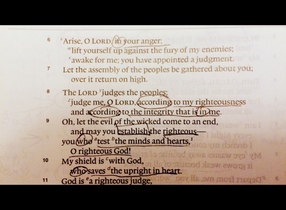 In America, we celebrate the holiday of thanksgiving once a year. We eat turkey, we watch football, we take time off. We dub this regimented indulgence, "Thanksgiving." We trace the tradition of yearly Thanksgivings specifically to our first fathers and mothers who came across on the Mayflower, but also through the presidency of Abraham Lincoln who instantiated the holiday of Thanksgiving. Well and good. Of course, how the practices of Thanksgiving actually relate to the command of God to be disciplined in giving thanks (Psalm 147:7) is something of a conundrum. We engage in the practice, but think little about the tacit formation. What does it mean to practice thanksgiving? Are our yearly practices of Thanksgiving actually congruent with the Scriptures' command on us to give thanks? To practice thanksgiving requires at least two steps. 1 - It is to acknowledge that everything that we have is from one another. This requires a pain-staking humility. To truly give thanks, we must come to an end of ourselves. We must look to something we have which we could not have attained for ourselves. Thanksgiving is the discipline where the gifted gratefully reflects on the gift the giver gave him which he could not have given himself. In other words, it requires us to say, "This came from someone else. It is gratuitous." The theoretical reason food is associated with with gift giving is an acknowledgement that that sustenance comes from another. We indulge in a whole array of foods and fill ourselves, and after we wake up from our food coma, we recognize that we could not have achieved that on our own. This is why we pray with thanksgiving at the beginning of every meal. It is to recognize that this comes from somewhere else, not ourselves. We recognize all that God has given us, all that God has showered on us and lavished on us. We recognize it is totally undeserved. It is not something we did to deserve it. This is the step that most people feel comfortable with. 2 - It is to reflect on what this implies about the character of the giver. If the giver gave the gifted such a gift, what does that imply about the giver? This is the step we don't care for. We don't take this step of thanksgiving first, because it requires work, and second, because the results can be somewhat disconcerting. For example, if I have much on my table, it is easy to give thanks. How generous this implies my God is! How wonderfully this compels me to think of him! But when all that is in my cornucopia are crumbs of stale bread or scraps of singed meat, what does this imply about God? That he has a purpose in my pain? I don't want to think about that. It is easy to give thanksgiving on Thanksgiving, or even on Christmas. We can be thankful even then. But in January, when the sky is glum, the ground is wet, and the table is empty? Can we be thankful even then. Can we believe that God would use even those seasons in our lives, where we are lean and hungry, trembling and tired? The discipline of Thanksgiving teaches us to be so. This might be a difficult practice to wrap our minds around. Yet it is essential. Because, Thanksgiving teaches us how to come to our Savior. When we come to him, all our Thanksgiving emotions point every direction (Rev 7:12). Because when we see him crucified, shamed, emaciated, skinny, ugly, ghoulish, bloody, broken, bruised hanging on the cross, what does this imply about God? Can we give thanks, even for this? Yes, we can admit, we could not provide a sacrifice on our own, the gift for the gifted is not of himself. But can we admit that this is the God who does indeed provide? A sacrifice for our sake. A broken body for ours. A man estranged in our place? Indeed it is He. But we also see a lamb, standing as though it were slain. Not only has he been killed, he has also been enlivened. Not only has he been crucified, he has been resurrected. Not only was he lowered into the ground, he is risen. When we give thanks for this, the greatest of gifts, we recognize that this too, this is our God. The God who provides. The God whose gift is not only death, but also life. Not only darkness, but also light. This thanksgiving, whether with plenty or little, with full or empty plates, give thanks to this God. The God who gave one to die for you, and gave one to life for you. The God who gave the lamb who is standing though he has been slain. Come to an end of yourself, and there you will begin to come to Him. "Nothing in my hand I bring, simply to the cross I cling."  A lot of people think that reading, understanding, and applying the Bible is something for leaders (pastors, professors, elders, small group leaders) but not for me. This is a pretty common attitude, and sometimes, unfortunately, it's perpetuated by well intentioned leaders or some with an inflated sense of their own importance. But God has made his Word available to all his people, not just the leaders of the church. Howard Hendricks sets out 3 simple steps for good Bible study that everyone can do in his book Living by the Book. It's helpful to think of these as 3 "buckets" to put your questions about the Bible into. Here they are: Observation: Make as many observations about a passage as you possible can. Ask questions like these:
Interpretation: Try to understand the meaning of this passage that is behind all the details of the passage:
Application: Try to find specific ways to apply this passage to your life.
|
Southern Heights Christian ChurchCome here for thoughts on how to follow Jesus in our every day life! Archives
January 2022
Categories
All
|
Telephone |
Address5401 Madison Ave
Anderson, IN 46013 |
ServicesSunday School :: 9 AM
Sunday Service :: 10:30 AM |

 RSS Feed
RSS Feed